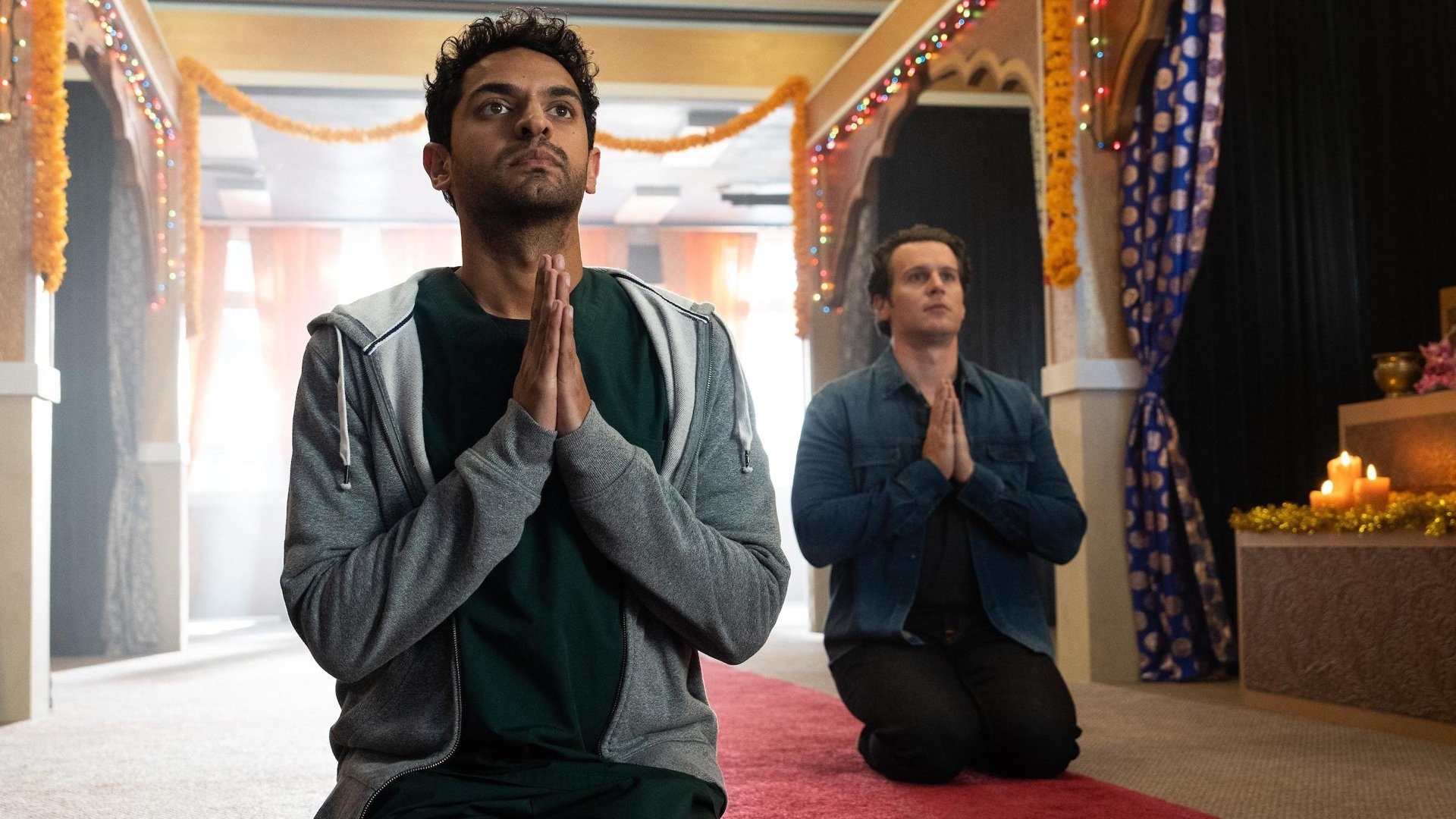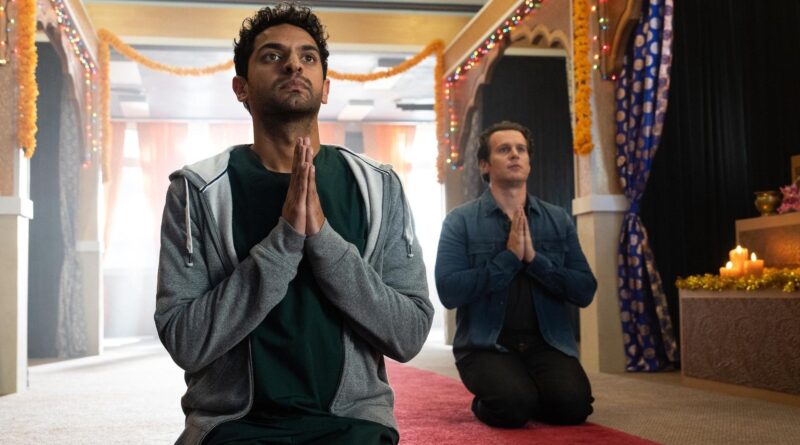‘A Nice Indian Boy’ review: East-meets-West with a twist in an instant rom-com classic

An incisive expression of family and culture that neither apologizes nor over-explains itself, Roshan Sethi’s A Nice Indian Boy is a riotous, moving queer romantic comedy with a wildly unique premise. While it resembles many modern third-culture stories — specifically, tales of disconnect between first-generation South Asians in the West and their immigrant parents — it widens its scope in surprising ways that reflect and refract both personal and cinematic identity.
Taking inspiration from a romantic Bollywood classic, the film follows a gay Indian American doctor whose parents are nominally accepting, but who want him to find “a nice Indian boy.” Long story short: He does! The immediate wrinkle, however, is that this nice Indian boy is none other than Jonathan Groff — yes, Hamilton‘s original King George — playing a white man raised by Indian parents.
On one hand, A Nice Indian Boy is the tale of a typical Indian American family, with typical Indian American problems — a generational disconnect, gendered double standards, and a culture of awkward silence around sexuality — but on the other hand, its evolution into grand romantic saga is anything but typical. It’s also a story of cross-cultural adoption that dovetails into not only a hilariously awkward meet-the-parents comedy, but also a film about freeing oneself from emotional and generational baggage, in a way that yields tears of joy and laughter.
What is A Nice Indian Boy about?
Dr. Naveen Gavaskar (Deadpool‘s Karan Soni) is the kind of realistic queer protagonist seldom seen in Hollywood: an introverted gay man who’d rather be at home than at the club — or in the case of the movie’s opening scene, at his sister’s colorful wedding reception. As the guests dance to thumping tunes, and the camera tilts and spins to capture them, Naveen sits still, fending off over-enthusiastic family members whose words of marital encouragement sound more like a dire warning: “You’re next!”
What Naveen’s nosy aunties and uncles don’t know, and what his parents begrudgingly accept, is that his wedding won’t quite look like a Hindi movie, since he happens to be into guys.
Six years go by — notably, the amount of time between Sethi coming out and the film’s premiere — and Naveen’s life away from his parents is somewhat content, even though it involves lonely nights of leaving exes and crushes some uncomfortably awkward voice messages. He has absolutely no game, despite the efforts of his outgoing gay colleague Paul (Peter S. Kim) to bring him out of his shell. But the gods eventually smile on him when he comes across an attractive white photographer, Jay Kurundkar (Groff), at his local mandir (or temple) while praying to a statue of Ganesh, the elephant-headed Hindu god of wisdom and good luck.
Two things immediately stand out about Jay: his tranquil charm, and his authentic pronunciation of “Ganesh” — with an extended “e” as in “lace,” rather than the protracted “e” of words like “less,” to which most Westerners default. Naveen is immediately flustered by Jay’s confident stares, but agrees to accompany him on a date to his favorite movie, which, to the good doctor’s surprise, turns out to be Dilwale Dulhania Le Jayenge (or DDLJ), the iconic 1995 Bollywood romance about two star-crossed Indian Londoners, whose musical centerpiece features superstar Shah Rukh Khan serenading actress Kajol in a field of yellow mustard flowers.
But instead of being bowled over by this gesture, Naveen finds himself unable to fully embrace the film or Jay’s off-key crooning of its famous track, “Tujhe Dekha To” (yes, Groff sings it himself, with barely a syllable out of place). Sincerity and vulnerability remain obstacles to Naveen, even after he and Jay start dating. This proves mildly problematic when meeting each other’s friends, but it’s downright disastrous when the question of Jay meeting Naveen’s parents arises, given how little he’s told them about his white, freelance photographer boyfriend who vapes and waxes poetic about Hindi cinema.
The results are as side-splitting as they are disheartening, because the one lesson A Nice Indian Boy takes from DDLJ is that Indian romantic films are family dramas too. However, what initially seems hopeless ends up an exciting challenge, because Jay has also internalized this lesson. And, like Shah Rukh Khan’s brash Raj Malhotra, he’ll stop at nothing to win over the parents of the person he loves.
A Nice Indian Boy is also a family drama.
The film, written by Eric Randall, is based on the play by Madhuri Shekar, and it has the structure of a five-act play, with each section broken up by significant time jumps. This ends up serving a dual purpose. On one hand, this shifts the typical feel-good rom-com climax to the middle of the story, away from its usual place in most three-act Hollywood screenplays, where it serves as a resolution. In the process, A Nice Indian Boy allows for the realities of long-term romance and wedding planning to creep in through the corners of the frame, beyond the broad declarations of love.
On the other hand, it also allows each member of Naveen’s family to have their own dedicated section of the movie, during which they become a primary character. Like Naveen, his sister Arundhathi (Sunita Mani) harbors a grudge against their parents for the choices she did and didn’t have while growing up, including in matters of love, and she sees their increased leeway with Naveen as a matter of grave injustice. Meanwhile, their outspoken mother Megha (Zarna Garg) tries to smooth things over with both children, but since she’s just as hot-headed as her daughter, it’s easier said than done. In terms of temperament, Naveen takes after his father Archit (Harish Patel), though his silent acceptance of Naveen’s sexuality — while avoiding eye contact at all cost — hurts more than outright disapproval. Like his son, Archit has a problem with expressing himself honestly.
However, Megha and Archit’s genuine attempts to bridge the gap between themselves and Naveen also leads to some uproarious overcompensation, between the topics they bring up in Jay’s presence without any filter whatsoever, to their sincere attempts to educate themselves by binging raunchy reality shows on OutTV and bringing them up in conversation. It’s incredibly funny and incredibly sweet, but none of these superficial gestures — no matter how well-meaning — are a substitute for the real emotional work the Gavaskar family needs.
The film doesn’t let Naveen off the hook either, whether it comes to his avoidance of intimacy or the walls he keeps up between him and his family members. Those walls only start to come down after some rigorous and difficult dramatic moments, which Sethi directs with incredible command.
A Nice Indian Boy is brilliantly directed.
The film’s premise resembles a number of third-culture films and shows featuring South Asians in the West, like The Big Sick, Ms. Marvel, and Blinded by the Light. These stories of artistically driven first-gen kids and their immigrant parents who “just don’t understand” have settled into a rote rhythm in recent years. A fellow SXSW selection, the lukewarm The Queen of My Dreams, is a key example: a similarly Bollywood-inspired tale of a queer Pakistani Canadian who nominally reconciles with her conservative mother. It’s rarely a good sign when you can map out the beats of a story based on its cultural premise, but A Nice Indian Boy finds numerous visual and thematic ways to buck that trend.
It stands out, first and foremost, through its bustling visual energy, which not only captures the chaos and excitement constantly unfolding around Naveen — at weddings, family meetings, or parties hosted by Jay’s outgoing friends — but also serves to magnify his glum stillness as the camera pushes in and pulls out prominently during both comedy beats and charged emotional moments. The film’s comedy and drama stem from the same place: the tension of expectations, whether it involves Naveen wrestling with his prescribed role as an Indian man in the West; the implications of his queerness, according to his parents; or how Jay will fit into the Gavaskars’ family dynamic.
What Jay yearns for, as a perpetual outsider who found love in an Indian household once before, is just as vital to the movie as Naveen’s search for emotional authenticity. And when the film begins drawing more overtly from Bollywood iconography, it weaves together its grandiose romance from both their perspectives. To Jay, Hindi cinema is the ultimate expression of love and acceptance. To Naveen, it’s a cheesy façade. The truth, it turns out, may lie somewhere in between, with Sethi presenting the story’s key turning points as stylistic handshakes between formal grandeur and naturalistic, self-aware comedy, without compromising either character’s point of view. The movie’s sweeping declarations are as bold and unapologetic as they are goofy and silly, so they end up running the emotional gamut.
Rarely has a rom-com been this simultaneously hysterical and touching, though despite its boisterous tone, its biggest strength may very well be its silent moments. The father-son pairing of Naveen and Archit tend to find solace in silence, and that isn’t likely to change anytime soon. So, in order to draw them out of their comfort zones, A Nice Indian Boy becomes a film about gestures both big and small. Its most heartrending moments arrive in the form of these two men — separated by generational disconnect, but bound by common cultural expectations — adapting to other people’s modes of expression in the small ways they’re able to. Over the course of the film, they learn to speak other people’s love languages, leading to rousing, overwhelming moments (some of them in delightful musical form).
In a just world, A Nice Indian Boy would find instant distribution and be hailed alongside Mira Nair’s Monsoon Wedding as a realistic family portrait whose jagged edges aren’t just riveting, but revelatory. It’s as sweet and funny as they come, and the kind of crowd-pleaser destined to leave your heart feeling full.
A Nice Indian Boy was reviewed out of its World Premiere at SXSW 2024.
